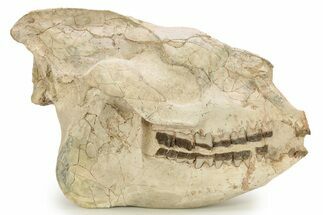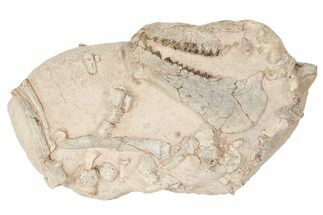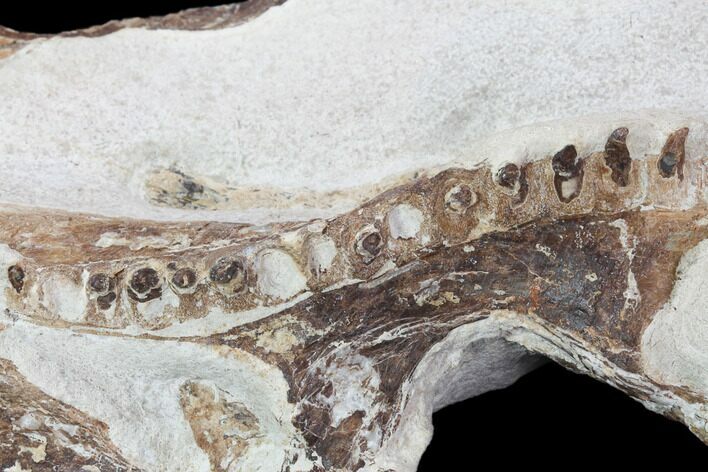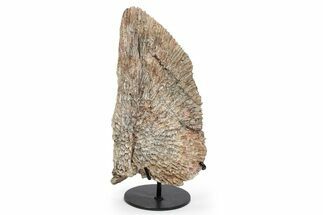This Specimen has been sold.
15" Fossil Mosasaur Skull Section - Goulmima, Morocco
This is a beautiful 15.0" fossil Plate containing Mosasaur (Tethysaurus) skull bones from Goulmima, Morocco. It contains the Frontal (forehead) bone, Parietal (top of the Head) Bone, Occipital (Back of skull), Right Squamosal, a portion of the left Maxxila (upper jaw) and the right Pterygoid bone with eleven teeth,. The Pterygoid bone forms the back of the roof of the mouth just above the throat and in some reptiles contains a second set of teeth that aid in swallowing prey. This amazing specimen is basically the back half of the skull. A rough calculation suggests that when the skull was intact it was approximately 16 inches (40 cm) long.
Comes with a display stand.
Comes with a display stand.
Mosasaurs were a family of enormous marine reptiles that truly dominated the seas 90 million years ago, ruling during the last 20-25 million years of the Cretaceous period. With the extinction of the ichthyosaurs and decline of plesiosaurs, mosasaurs diversified to become prolific apex predators in nearly every habitat of the oceanic world.
Larger mosasaurs were the great leviathans of their time, extending 10–15 meters, or 33–49 feet long. Hainosaurus holds the record for the longest mosasaur at a seemingly impossible 57 feet. The smaller genera were still an impressive 10–20 feet long.
Mosasaurs probably evolved from semi-aquatic scaled reptiles, perhaps more similar in appearance to modern-day monitor lizards. They had double-hinged jaws and flexible skulls much like that of a snake which enabled them to gulp down their prey almost whole.
The gruesome unchewed contents of fossilized mosasaur guts have revealed a varied diet of sea birds, ammonites, smaller marine lizards, possibly sharks, and even other mosasaurs. Ammonites were especially crunchy mosasaur treats. They were abundant in the Cretaceous seas, and some mosasaurs had specialized teeth for the job.
Mosasaurs probably lurked for an ambush, rather than hunt, using their powerful tail flukes for extra thrust to dart out and swallow unsuspecting prey. Non-reflective, keeled scales may have been a great advantage to the mosasaur sneak-attack.
Mosasaurs breathed air and gave birth to live young. The bronchi leading to the lungs run parallel to each other, instead of splitting apart from one another as in monitors and other terrestrial reptiles. They were well-adapted to living in the warm, shallow, epicontinental seas of the period.
Although mosasaurs diversified and proliferated at a spectacular rate, their specialization is considered the source of their demise when marine systems collapsed at the end of the Cretaceous.
Larger mosasaurs were the great leviathans of their time, extending 10–15 meters, or 33–49 feet long. Hainosaurus holds the record for the longest mosasaur at a seemingly impossible 57 feet. The smaller genera were still an impressive 10–20 feet long.
Mosasaurs probably evolved from semi-aquatic scaled reptiles, perhaps more similar in appearance to modern-day monitor lizards. They had double-hinged jaws and flexible skulls much like that of a snake which enabled them to gulp down their prey almost whole.
The gruesome unchewed contents of fossilized mosasaur guts have revealed a varied diet of sea birds, ammonites, smaller marine lizards, possibly sharks, and even other mosasaurs. Ammonites were especially crunchy mosasaur treats. They were abundant in the Cretaceous seas, and some mosasaurs had specialized teeth for the job.
Mosasaurs probably lurked for an ambush, rather than hunt, using their powerful tail flukes for extra thrust to dart out and swallow unsuspecting prey. Non-reflective, keeled scales may have been a great advantage to the mosasaur sneak-attack.
Mosasaurs breathed air and gave birth to live young. The bronchi leading to the lungs run parallel to each other, instead of splitting apart from one another as in monitors and other terrestrial reptiles. They were well-adapted to living in the warm, shallow, epicontinental seas of the period.
Although mosasaurs diversified and proliferated at a spectacular rate, their specialization is considered the source of their demise when marine systems collapsed at the end of the Cretaceous.
Tethysaurus was a small-to-medium-sized mosasaur that lived during the Early Turonian stage of the Late Cretaceous period, approximately 93 million years ago. It grew to around 10 feet (3 meters) in length and seemed to be a transitional species between some of the more primitive mosasaurs and later mosasaur groups. Its fossils have been found near the villages of Asfla and Tadirhourst in east-central Morocco.
Tethysaurus was named after Tethys, the ancient Greek goddess of the sea. The ancient Tethys Ocean, which once separated Laurasia (the northern continents) from Gondwana (the southern continents), is also named for this Greek goddess.
Tethysaurus was named after Tethys, the ancient Greek goddess of the sea. The ancient Tethys Ocean, which once separated Laurasia (the northern continents) from Gondwana (the southern continents), is also named for this Greek goddess.
SPECIES
Tethysaurus nopcsai
LOCATION
Asfla, Goulmima, Morocco
SIZE
15.0 x 7.4"
CATEGORY
SUB CATEGORY
ITEM
#107177
We guarantee the authenticity of all of our specimens.
 Reviews
Reviews





















